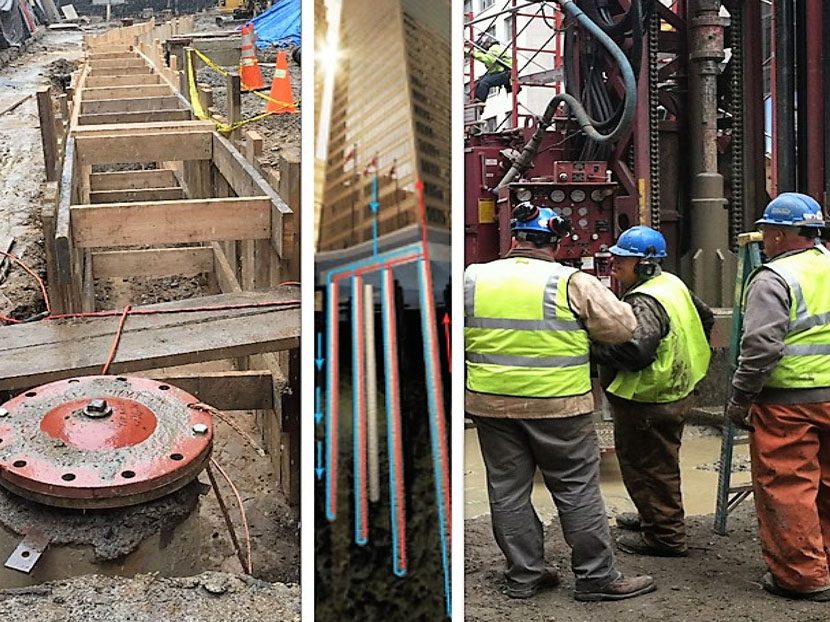Geothermal Without Boreholes
Consider unconventional heat-exchange strategies such as wastewater thermal energy recovery and the thermal capacity of water mains.

Several different types of geothermal exchange methods are available for designers, depending on the geology for a particular project. However, there are situations where geothermal excavation may not be required or even feasible. It's important to get outside one-dimensional thinking and look at other potential heat sources and heat sinks that may be in the vicinity.
Once we start looking outside the box, we may find situations where geothermal exchange can be accomplished without the addition of substantial infrastructure.
It's important to note that most geothermal exchange systems involve drilling boreholes for closed loop, open loop or standing column wells. Each has a place where they are most suitably applied. Let's review some of the common types of geothermal exchange in the industry.
Overall, there are six general geothermal exchange configurations; each one of them has a purpose and a place for their proper application.
• Closed-loop vertical exchange. This method can be configured in two-pipe, four-pipe, concentric and many other adaptations.
• Closed-loop horizontal exchange. This method can be configured in various ways to apply open-trench-based exchangers.
• Closed-loop pond/lake/ocean/surface water. These types of systems can be configured to use fabricated plate exchangers or polyethylene pipe arranged in the body of water.
• Closed-loop energy piles. Similar to closed-loop vertical exchange, these can be adapted in many different ways within the foundation pilings of a building.
• Open standing column well. The method primarily allows for a reduction in boreholes, allowing for a smaller footprint. It requires specific geology (competent bedrock).
• Open Class V well doublets. This method also allows for a reduction in boreholes, a smaller footprint and requires specific geology (abundant aquifer). The configuration is ideal for large-scale applications in hot and humid climates (cooling dominant).
Electrification and Dewatering
Electrification of a building’s central HVAC system is required to reduce on-site greenhouse gas emissions. It is fast becoming a necessity worldwide, notably in places such as New York, where ConEd, in mid-March, placed a moratorium on new natural gas hookups in Westchester County. But the answer is not always as simple as drilling boreholes for geothermal exchange. Often, little surface area is available for boring or excavation except for the sidewalk in front of the building.
Many of the mechanical rooms in these buildings are found on the top floors, near the roof for convenient connection to the cooling towers and easy ventilation of combustion gases emitted from gas-fired boilers or chiller equipment. Many of these clients are located in impossibly-tight urban environments.
As we focus on overcoming some of the hurdles involved in the electrification of skyscrapers and other large buildings in dense environments, we will find that many of these solutions play into coupling a building’s mechanical exchange system with existing infrastructure. Because most cooling towers, chillers and boilers are located near the top floor of a building, part of the electrification process requires hydronic piping run to the street level to utilize existing infrastructure as a heat sink and a heat source.
Coincidentally, there is a growing need for dewatering infrastructures such as below-grade structures, parking garages and subway tunnels. These are operations that may be “dual-purposed” for geothermal exchange integration.
A study conducted by New York's Metropolitan Transportation Authority indicates that several buildings are in the vicinity of dewatering operations as the water travels and discharges into the Hudson or East Rivers. This represents thousands of tons of potential heating and cooling capacity on each street under which these discharge lines are run.
When this is accomplished, three or four exchangers can be placed near the base of the building, providing closer access to the heat source and heat sink capacities of any number of exchange sources. These may include wastewater, dewatering operations, reclaimed water effluent and even potable water. You can read more about this technique in the Oak Ridge National Laboratory’s 2018 report titled, Evaluation of the Impacts of Heat Exchanger Operation on Quality of Water Used as Heat Source and Sink.
Still, many more buildings and campuses are positioned near other types of infrastructure suitable for heat exchange. Some of these include effluent discharge from wastewater treatment facilities, reclaimed water lines and, of course, surface water exchange. To open our collective minds about these situations, consider the following real opportunities for geothermal exchange systems that are well-suited to take advantage of their thermal capacity:
- Potable water
- Sanitary sewer
- Irrigation water
- Greywater
- Reclaimed water
- Lake and surface water
It's time to start thinking of buildings and infrastructure as one. If we live in silos, abundant opportunities to share efforts are missed.
“One of the ideas we were encouraging the design team to consider was that everything has more than one job,” said Asim Tahir, a project executive with Google’s Real Estate and Workplace Services discussing the company’s new office building with Fast Company. “If there’s an element in the building that is only serving one function; that’s missing out on potential opportunities. That’s the sort of thinking that led us to combine the geothermal element into the piles.”





